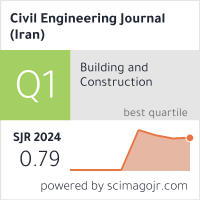Optimizing the Flexural Behavior of Bamboo Reinforced Concrete Beams Containing Cassava Peel Ash using Response Surface Methodology
Downloads
Doi:10.28991/CEJ-2023-09-08-011
Full Text:PDF
Downloads
[2] Mali, P. R., & Datta, D. (2020). Experimental evaluation of bamboo reinforced concrete beams. Journal of Building Engineering, 28. doi:10.1016/j.jobe.2019.101071.
[3] Aí¯tcin, P. C., & Mindess, S. (2011). Sustainability of Concrete. CRC Press, London, United Kingdom. doi:10.1201/9781482266696.
[4] Rahim, N. L., Ibrahim, N. M., Salehuddin, S., Mohammed, S. A., & Othman, M. Z. (2020). Investigation of bamboo as concrete reinforcement in the construction for low-cost housing industry. IOP Conference Series: Earth and Environmental Science, 476(1), 012058. doi:10.1088/1755-1315/476/1/012058.
[5] Mali, P. R., & Datta, D. (2018). Experimental evaluation of bamboo reinforced concrete slab panels. Construction and Building Materials, 188, 1092–1100. doi:10.1016/j.conbuildmat.2018.08.162.
[6] Perera, P. M. D. J. S., & Lewangamage, C. S. (2015). Experimental investigation on flexural behaviour of bamboo reinforced concrete slab panels. Annual Sessions of IESL, 108th Annual Transactions, The Institution of Engineers, Colombo, Sri Lanka.
[7] Awolusi, T. F., Borode, A. P., & Aluko, O. G. (2022). An Evaluation of the Flexural and Durability Properties of Bamboo-Reinforced Concrete Prism. Iranian Journal of Science and Technology - Transactions of Civil Engineering, 46(6), 4343–4353. doi:10.1007/s40996-022-00957-z.
[8] Qaiser, S., Hameed, A., Alyousef, R., Aslam, F., & Alabduljabbar, H. (2020). Flexural strength improvement in bamboo reinforced concrete beams subjected to pure bending. Journal of Building Engineering, 31(101289). doi:10.1016/j.jobe.2020.101289.
[9] Dey, A., & Chetia, N. (2018). Experimental study of Bamboo Reinforced Concrete beams having various frictional properties. Materials Today: Proceedings, 5(1), 436–444. doi:10.1016/j.matpr.2017.11.103.
[10] Archila, H., Kaminski, S., Trujillo, D., Zea Escamilla, E., & Harries, K. A. (2018). Bamboo reinforced concrete: a critical review. Materials and Structures / Materiaux et Constructions, 51(4), 1-18. doi:10.1617/s11527-018-1228-6.
[11] Schneider, N., Pang, W., & Gu, M. (2014). Application of Bamboo for Flexural and Shear Reinforcement in Concrete Beams. Structures Congress 2014. doi:10.1061/9780784413357.091.
[12] Kumar, P. V., & Vasugi, V. (2014). Study on mechanical strength of bamboo reinforced concrete beams. International Journal of Advances in Science Engineering and Technology, 2(3), 103-105.
[13] Siddika, A., Mamun, M. A. Al, & Siddique, M. A. B. (2017). Evaluation of Bamboo Reinforcements in Structural Concrete Member. Journal of Construction Engineering and Project Management, 7(4), 13–19. doi:10.6106/JCEPM.2017.7.4.013.
[14] Bashir, A., Gupta, C., Abubakr, M. A., & Abba, S. I. (2018). Analysis of Bamboo Fibre Reinforced Beam. Journal of Steel Structures & Construction, 04(02), 2–7. doi:10.4172/2472-0437.1000146.
[15] Amada, S., Ichikawa, Y., Munekata, T., Nagase, Y., & Shimizu, H. (1997). Fiber texture and mechanical graded structure of bamboo. Composites Part B: Engineering, 28(1–2), 13–20. doi:10.1016/s1359-8368(96)00020-0.
[16] Thomas, B. S., Gupta, R. C., Kalla, P., & Cseteneyi, L. (2014). Strength, abrasion and permeation characteristics of cement concrete containing discarded rubber fine aggregates. Construction and Building Materials, 59, 204–212. doi:10.1016/j.conbuildmat.2014.01.074.
[17] Prusty, J. K., & Patro, S. K. (2015). Properties of fresh and hardened concrete using agro-waste as partial replacement of coarse aggregate - A review. Construction and Building Materials, 82, 101–113. doi:10.1016/j.conbuildmat.2015.02.063.
[18] Maddalena, R., Roberts, J. J., & Hamilton, A. (2018). Can Portland cement be replaced by low-carbon alternative materials? A study on the thermal properties and carbon emissions of innovative cements. Journal of Cleaner Production, 186, 933–942. doi:10.1016/j.jclepro.2018.02.138.
[19] Fernández, í., García Calvo, J. L., & Alonso, M. C. (2018). Ordinary Portland cement composition for the optimization of the synergies of supplementary cementitious materials of ternary binders in hydration processes. Cement and Concrete Composites, 89, 238–250. doi:10.1016/j.cemconcomp.2017.12.016.
[20] Awolusi, T., Taiwo, A., Aladegboye, O., Oguntayo, D., & Akinkurolere, O. (2022). Optimisation of quinary blended supplementary cementitious material for eco-friendly paving unit using taguchi orthogonal array design. Materials Today: Proceedings, 65, 2221–2227. doi:10.1016/j.matpr.2022.06.263.
[21] Erdem, T. K., & Kirca, Ö. (2008). Use of binary and ternary blends in high strength concrete. Construction and Building Materials, 22(7), 1477–1483. doi:10.1016/j.conbuildmat.2007.03.026.
[22] Charitha, V., Athira, V. S., Jittin, V., Bahurudeen, A., & Nanthagopalan, P. (2021). Use of different agro-waste ashes in concrete for effective upcycling of locally available resources. Construction and Building Materials, 285, 122851. doi:10.1016/j.conbuildmat.2021.122851.
[23] Adesanya, O. A., Oluyemi, K. A., Josiah, S. J., Adesanya, R., Shittu, L., Ofusori, D., ... & Babalola, G. (2008). Ethanol production by Saccharomyces cerevisiae from cassava peel hydrolysate. The Internet Journal of Microbiology, 5(1), 25-35. doi:10.5580/4f1.
[24] Salau, M. A., & Olonade, K. A. (2011). Pozzolanic Potentials of Cassava Peel Ash. Journal of Engineering Research, 16(1), 10–21.
[25] Haryanto, Y., Wariyatno, N. G., Hu, H. T., Han, A. L., & Hidayat, B. A. (2021). Investigation on Structural Behaviour of Bamboo Reinforced Concrete Slabs under Concentrated Load. Sains Malaysiana, 50(1), 227–238. doi:10.17576/jsm-2021-5001-22.
[26] Awolusi, T. F., Oke, O. L., Akinkurolere, O. O., & Sojobi, A. O. (2019). Application of response surface methodology: Predicting and optimizing the properties of concrete containing steel fibre extracted from waste tires with limestone powder as filler. Case Studies in Construction Materials, 10. doi:10.1016/j.cscm.2018.e00212.
[27] Ahmed, T., Ray, S., Haque, M., Tasnim Nahin, T., & Ferdous Mita, A. (2022). Optimization of properties of concrete prepared with waste glass aggregate and condensed milk can fiber using response surface methodology. Cleaner Engineering and Technology, 8, 100478. doi:10.1016/j.clet.2022.100478.
[28] ASTM. C642-13. (2022). Standard Test Method for Density"š Absorption "šand Voids in Hardened Concrete. ASTM International Pennsylvania, United States. doi:10.1520/C0642-13.
[29] ASTM D2915-03. (2010). Standard practice for shotcrete Evaluating Allowable Properties for Grades of Structural Lumber. ASTM International Pennsylvania, United States. doi:10.1520/D2915-03.
[30] BS 1881: Part 104: 1983. (1983). Testing concrete Part 102. Method for determination of Slump. British Standard, London, United Kingdom.
[31] Yalcin D. (2020). Material Testing System Manufacturer, ADMET. Available online: https://www.admet.com/blog/flexural-testing-essentials/. (accessed on June 2023).
[32] Alyamac, K. E., Ghafari, E., & Ince, R. (2017). Development of eco-efficient self-compacting concrete with waste marble powder using the response surface method. Journal of Cleaner Production, 144, 192–202. doi:10.1016/j.jclepro.2016.12.156.
[33] Mohammed, B. S., Khed, V. C., & Nuruddin, M. F. (2018). Rubbercrete mixture optimization using response surface methodology. Journal of Cleaner Production, 171, 1605–1621. doi:10.1016/j.jclepro.2017.10.102.
[34] Esfahanian, M., Nikzad, M., Najafpour, G., & Asghar Ghoreyshi, A. (2013). Modeling and optimization of alcoholic fermentation with saccharomyces cerevisiae: Response surface methodology and artificial neural network. Chemical Industry and Chemical Engineering Quarterly, 19(2), 241–252. doi:10.2298/CICEQ120210058E.
[35] Fjodorova, N., & NoviÄ, M. (2015). Searching for optimal setting conditions in technological processes using parametric estimation models and neural network mapping approach: A tutorial. Analytica Chimica Acta, 891, 90–100. doi:10.1016/j.aca.2015.06.020.
[36] Prakash Maran, J., Sivakumar, V., Thirugnanasambandham, K., & Sridhar, R. (2013). Artificial neural network and response surface methodology modeling in mass transfer parameters predictions during osmotic dehydration of Carica papaya L. Alexandria Engineering Journal, 52(3), 507–516. doi:10.1016/j.aej.2013.06.007.
[37] Myers, R. H., Montgomery, D. C., Geoffrey Vining, G., Borror, C. M., & Kowalski, S. M. (2004). Response Surface Methodology: A Retrospective and Literature Survey. Journal of Quality Technology, 36(1), 53–78. doi:10.1080/00224065.2004.11980252.
[38] Cau Dit Coumes, C., & Courtois, S. (2003). Cementation of a low-level radioactive waste of complex chemistry - Investigation of the combined action of borate, chloride, sulfate and phosphate on cement hydration using response surface methodology. Cement and Concrete Research, 33(3), 305–316. doi:10.1016/S0008-8846(02)00943-2.
[39] Haque, M., Ray, S., Mita, A. F., Bhattacharjee, S., & Shams, M. J. Bin. (2021). Prediction and optimization of the fresh and hardened properties of concrete containing rice hush ash and glass fiber using response surface methodology. Case Studies in Construction Materials, 14. doi:10.1016/j.cscm.2021.e00505.
[40] Poorarbabi, A., Ghasemi, M., & Moghaddam, M. A. (2020). Concrete compressive strength prediction using non-destructive tests through response surface methodology. Ain Shams Engineering Journal, 11(4), 939-949. doi:10.1016/j.asej.2020.02.009.
[41] Chaliha, C., Kalita, E., & Verma, P. K. (2020). Optimizing In vitro Culture Conditions for the Biotrophic Fungi Exobasidium vexans Through Response Surface Methodology. Indian Journal of Microbiology, 60(2), 167–174. doi:10.1007/s12088-019-00846-6.
[42] Aldahdooh, M. A. A., Muhamad Bunnori, N., & Megat Johari, M. A. (2013). Evaluation of ultra-high-performance-fiber reinforced concrete binder content using the response surface method. Materials & Design (1980-2015), 52, 957–965. doi:10.1016/j.matdes.2013.06.034.
[43] Umeonyiagu, I. E., & Nwobi-Okoye, C. C. (2019). Modelling and multi objective optimization of bamboo reinforced concrete beams using ANN and genetic algorithms. European Journal of Wood and Wood Products, 77, 931-947. doi:10.1007/s00107-019-01418-7.
[44] Govindan, B., Ramasamy, V., Panneerselvam, B., & Rajan, D. (2022). Performance assessment on bamboo reinforced concrete beams. Innovative Infrastructure Solutions, 7, 1-13. doi:10.1007/s41062-021-00616-8.
- Authors retain all copyrights. It is noticeable that authors will not be forced to sign any copyright transfer agreements.
- This work (including HTML and PDF Files) is licensed under a Creative Commons Attribution 4.0 International License.![]()















